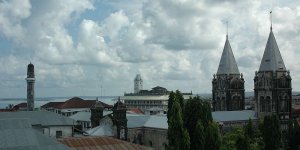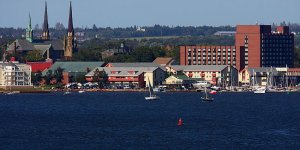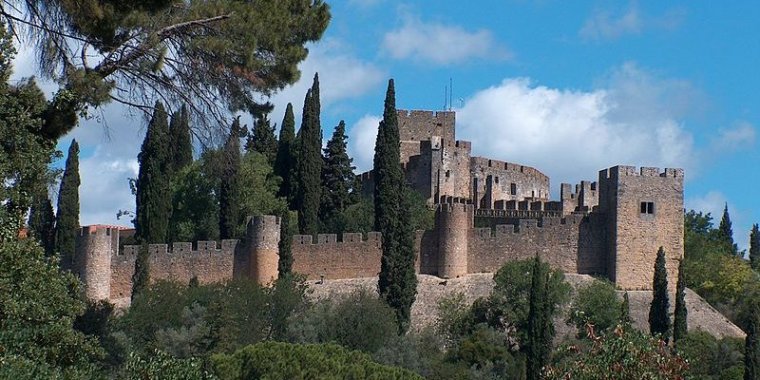| Published in Destinations |
Tomar, Portugal
The town of Tomar was born inside the walls of the Convento de Cristo, constructed under the orders of Gualdim de Pais, the fourth grand master of the Knights Templar in the late 12th century.
Tomar is one of Portugal's historical jewels and more significantly was the last Templar town to be commissioned for construction. Tomar was especially important in the 15th century when it was a centre of Portuguese overseas expansion under Henry the Navigator, the Grand Master of the Order of Christ, successor organization to the Templars in Portugal.
The Nabão River cuts across what was the ancient city of Nabantia: its inhabitants are called Nabantinos.
It is rumored that Tomar hides the world's greatest templar treasure and that there is a secret passageway between the Santa Maria dos Olivais church and the Castle.
Get in
By train (via Entroncamento), by bus or car.
• Lisbon: There is hourly direct train to/from Lisbon (Santa Apolonia/Oriente), (ap. 2 h), 8.40 €.
• Porto: Several per day, (ap. 3.5 h), 19 €, need to change in Entrocamento or Lamarosa/Coimbra B.
There are two bus companies that connect Tomar: Rede Expressos and Rodoviária do Tejo.
Get around
Walking; it is a small city. There is also citybus, 3 lines, 0.85 €/ticket valid for 1.5 h.
What to See in Tomar
Tomar is a small city but holds an important ancient past and some of the most important monuments in Portugal.
• Convent of Christ and Castle of Tomar (Convento de Cristo and Castelo de Tomar). UNESCO World Heritage Site, built in 12th century. After the Order of the Knights Templar was dissolved in the 14th century, the Portuguese branch of the order was turned into the Knights of the Order of Christ, which supported Portugal's maritime discoveries of the 15th century. Entrance 6 €, free on Sundays and holidays till 2 pm.
• Church of Santa Maria do Olival. it was built in the second half of the 12th century by the provincial master of the Order of the Knights Templar in Portugal, Gualdim Pais.
• Church of Saint John the Baptist and Republic Square, this church was built in the end of the 15th century, marked as National Monument in 1910 and is in Republica Square where is Gualdim Pais statue.
• Aqueduct of Pegões, (Quinta dos Pegões), it was built to deliever water to Convento de Cristo and has 6 km of extension. The construction started in 1593 and finished in 1614. The highest point of this aqueduct is 30 m above ground level. Take the small "train tour bus" in city center that takes you to the highest point. The easiest way to go to aqueduct is to follow the local road to Leiria.
• Synagogue of Tomar. is the best preserved of the medieval synagogues of Portugal. It is located in the historic centre of the city of Tomar, and houses a small Jewish Museum.
• Museum of Matches (Museu dos Fósforos), Av. Gen. Bernardo Faia, near raliway station. Surprisingly nice exhibition of matches's boxes all over the world. Open daily 2pm-5pm, free entrance.
• Chapel of Our Lady of the Conception (Nossa Senhora da Conceição): Chapel built between 1532 and 1540 in pure Renaissance style, begun by João de Castilho and finished by Diogo de Torralva. It was intended to be the burial chapel of King John III. Its beautiful and clear architecture turns it into one of the best early Renaissance buildings in Portugal. It's one of the first Maneirist Monuments of all Europe.
• Church and Convent of Saint Iria: Located near the Nabão river, this early 16th-century building has a nice Renaissance portal and altar, as well as Manueline architectonic details.
• Museu de Arte Moderna - Colecção José Augusto França (Art Gallery)
• Casa Museu Fernando Lopes Graça
• Casa dos Cubos (Art Gallery)
What to Do in Tomar
• Festa dos Tabuleiros. Is a festival organized every 4 years during summer (beginning of July). It an old tradition and in every event, Tomar becomes completely crowded and visitants can enjoy original decoration of streets, music concerts, traditional gastronomy and of course the main part of festival the trays parade.
• Festival Bons Sons (Cem Soldos) - One of the most popular Portuguese Music Festivals.
• Festival Internacional de Tunas da Cidade de Tomar
• Beer Fest of Tomar
• Summer fests in Tomar district - Serra Tomar is the largest one.
• Knights Templar Festival.
• O Vale dos Cavalos - horse riding lessons, trail riding and horse holidays.
Eat
• Cervejaria do Fernando - serves typical portuguese meals from lunchtime till midnight ~6 €. Open: Tu-Su: 10am-1am, closed on Mondays.
• Restaurante Baía (são João Batista), +351 249 315 956. Open for lunch and from 17h00 to midnight. Portuguese food mainly meat and fish, vegetarian soup and salads. Inexpensive, big pan of arroz marinero 22 euros for 2 persons.
Drink
• Cafe Paraiso situated in the main street, the oldest bar in the city.
Sleep
Budget
• Residencal União, Rua Serpa Pinto Nº 94, +351 249 323 161. Single room: 20-28 €, double: 30-45 €, triple: 45-50 €, breakfast included. No credit cards accepted.
• Residencal Luz, Rua Serpa Pinto Nº 144, +351 249 312 317. Single: 17-20 €, Double: 22.5-32.5 €.
• Residencial Cavaleiros de Cristo, Rua Alexandre Herculano Nº 7, +351 249 321 203, +351 249 321 067. *** Single: 30 €, double: 50 €, 4 beds room 80 €.
Mid-range
• Estalagem de santa Iria, +351 249 313 326. Mouchão Parque. Single: 40-65 €, Double: 60-85 €, breakfast included.
Splurge
• Hotel dos Templarios, Largo Candido dos Reis 1, +351 249 310 100.
Go next
• Fátima (Sanctuary of Our Lady) – Place of the worldwide famous Marian apparitions.
• Batalha (Monastery)
• Alcobaça (Monastery)
• Nazaré (Beach of the Guiness Book Records big waves surfed). (Wikivoyage, Wikipedia)
See also Tomar in Pictures.
YOU MAY ALSO LIKE





 If you own or manage a travel-related business such as a hotel, a bed-and-breakfast, a restaurant, a pub or a cafeteria, you can create a web page for your business for free on Titi Tudorancea Travel Info. » |

